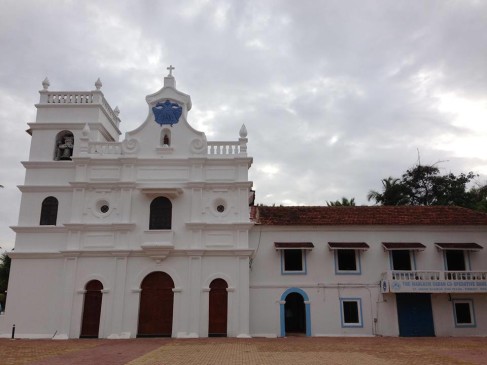Image Source: daijiworld.com
“The Franciscan priests, who resided on Pilar hillock, decided on this procession of saints so that the faithful could mend their ways, as the saints are leaders who should be an inspiration to all”. Goa is the only other place besides Rome that such a procession is held since centuries.
The two unique processions that continue to the day are the procession of ‘Capas Magnas’ at the Se Cathedral, commonly known as ‘Xeppedeochea Pursanv’, on Good Friday and the Procession of ‘Ordem Terceira’, known as ‘Santachem Pursanv’, at Goa Velha, on Monday after the passion Sunday (fifth Sunday of Lent).
Devotees enter the Church and express their devotion to particular saints by kissing and touching the statues whilst deep in prayer. An outdoor sermon follows and by sundown the statues, mounted on floats, are brought out in succession from the door of St.Andrew’s Church around the square and through the streets of the village. As each of the 31 statues emerges, a priest speaking through a microphone narrates the life-story of each saint in Konkani.
As the saints are carried through the crowd, devotees can be seen ducking under the floats to receive the blessing of the saints and to obtain purification for their confessed sins. The lifesize statues of 31 saints are kept for veneration for three days in the church after the procession. Goa is the only other place besides Rome that such a procession is held since centuries. They say that earlier nearly 100 statues would be taken out in procession, but where would they find so many confraria members to carry the heavy statues. In another unique tradition, people queue along the route and pass under the statues to receive blessings as the procession proceeds.

About Goa Velha
Goa Velha, a serene village famous Procession of the Saints at St.Andrew’s Church, has a rich history which began long before the arrival of the Portuguese. Jayakeshi-I of the Kadamba Dynasty (allies to and ruled by their overlords, the Chalukyas) then constructed a new capital called ‘Govapuri’ at the mouth of the Zuari River in 1054. ‘Govapuri’ is now modern day Goa Velha. Located ideally for trade, this port city grew quickly with the revenues coming in from the trade of Arabian horses, Chinese silks, and spice from the Hindu Colonies in South East Asia.
Now a sleepy village, Goa Velha, the former properous city of the Kadamba Dynasty, hosts the renowned Procession of the Saints on the first Monday of Easter week. This tradition began in the 17th century by the Franciscan Order in an attempt to boost the moral values and pious behaviour of the community and inspire them to take to their hearts the teachings of Jesus Christ.
By the 18th century, a total of 65 life-size richly decorated statues of saints, martyrs, kings, and queens were carried in palanquins on the shoulders of Native Christians. In 1835, the event was banned by the Marquis of Pombal and many statues were destroyed. The celebration began again only towards the end of the 19th century.
Read Full History of Procession of Saints: http://www.navhindtimes.in/procession-of-saints-a-way-to-seek-penance-for-sins/


